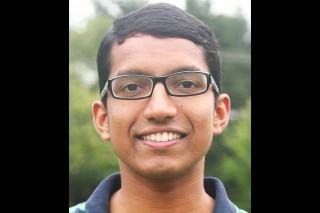Five Questions with Srikrishna Karanam (RPI, MS ’14, PhD ’17)
Former ALERT student researcher, Srikrishna Karanam, reflects on his time with ALERT and how it prepared him for working in the Homeland Security Enterprise.
Srikrishna joined ALERT in 2013 as a graduate student working with Prof. Richard J. Radke at Rensselaer Polytechnic Institute (RPI) on video analytics problems in camera networks. At RPI, he earned his MS in Electrical Engineering and his Ph.D. in Computer and Systems Engineering. Srikrishna is now working as a Research Scientist at Siemens Corporate Research, focusing on computer vision and machine learning.
What professional development opportunities, aside from research experience, benefitted you during your time as an ALERT student?
SK: During my time as an ALERT student, I attended several major conferences in Computer Vision – CVPR 2015 in Boston, MA, BMVC 2015 in Swansea, UK and ICCV 2015 in Santiago, Chile. Going to these conferences allowed me to discuss open problems and establish connections with several researchers in my field. Furthermore, I participated in several ALERT events – ASPIRE, ADSA, and ALERT annual meetings – where I got opportunities to present my work to several stakeholders in the security and surveillance industry.
These ALERT events were crucial in that they helped me focus my algorithmic and systems research on operational aspects from an end-user’s perspective – I believe these are critical issues as we transition laboratory research into working prototypes in the real world.
We understand that you were working under the supervision of former ALERT student, Ziyan Wu (RPI, PhD ‘14) during an internship with Siemens Corporate Research (Princeton, NJ) last year. What were some highlights from that experience?
SK: I was given a lot of independence in addressing existing problems the group at Siemens was tackling. This gave me an opportunity to explore several algorithmic as well as implementation and engineering components of the project I was assigned to. At the algorithmic level, I developed new algorithms and demonstrated improved performance on internal datasets. In addition, I assisted the group in integrating these algorithms as part of a large system that has been deployed for in-the-field testing.
This assignment provided me with valuable, real-world, hands-on research experience. Ziyan and others in the Vision Technologies and Solutions group were very supportive, kind, and welcoming, and I thoroughly enjoyed working there and developed great friendships along the way.
During your time at ALERT, you collaborated with ALERT teams from RPI, Northeastern University, and Boston University. Can you tell us a little bit about these collaborations and how they have prepared you to work in industry? Have you continued these collaborations post-graduation?
SK: I worked with the ALERT teams from RPI, Northeastern University, and Boston University on the VAST “Tag and Track” project (see related video at: https://alert.northeastern.edu/news-article/alert-101-is-back/) for over 3 years. Each team was responsible for specific parts of the project, with the goal of deploying and testing a working prototype of the system at the Cleveland International Airport, which was successfully achieved in Summer 2015.
The “Tag and Track” project provided me with real-world research, development, and project management experience, helping develop skills that are particularly relevant to industrial research labs. At Siemens Corporate Technology, I have been working on solving vision problems with practical relevance across multiple industrial units, and my experience with ALERT has helped me transition into my current work environment seamlessly.
Because of this project, I developed close collaborations (and friendships) with several researchers from Northeastern (specifically, Mengran Gou (NU, PhD ’17) and Oliver Lehmann (NU, PhD ’15)) in addition to Ziyan Wu and Austin Li (RPI, PhD ’15) from RPI. For instance, since the winter of 2015, Mengran and I have been closely collaborating on a project where our goal is to benchmark the current state-of-the-art in person re-identification for the convenience of the larger research community – as part of this work, we have evaluated several hundreds of different algorithms on numerous public datasets. Ziyan and I have been closely working together on numerous problems for many years – initially at RPI and now at Siemens.
Can you describe your role at Siemens and the research you are conducting now?
SK: I work as a Research Scientist in the Vision Technologies and Solutions group at Siemens Corporate Technology, where I research topics in Computer Vision and Machine Learning. I am responsible for developing algorithms to address research problems, as well as prototype systems that leverage these algorithms to solve real-world problems. My current research focuses on all aspects of image indexing, search, and retrieval with applications in object recognition and pose estimation.
Where do you see yourself in 5 years?
SK: My past research experience at RPI and ALERT has made me realize the importance of, and challenges in, getting lab-optimized research to work effectively in the “wild” real-world. To this end, I hope to contribute towards bridging this “gap,” enabling and building systems that offer Computer Vision, Machine Learning, and Data Analytics technologies as services to solve a wide variety of real-world problems.


There are currently no comments.
The comments are closed.